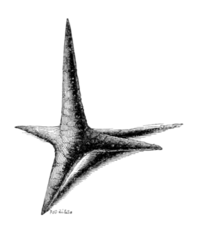some objects of great rarity, namely, caltraps, formed of four points radiating, each in a different plane, from a common centre, as shown in the woodcut.
It has been supposed that these were used, as in Roman races at the present time, where the horses run without riders, to stimulate their speed, being attached to pendant straps in place of the calcar. This is possible; it is certain that caltraps were used in Roman times to annoy cavalry. Vegetius relates how advantageously tribuli were scattered by the Romans, when assailed by the scythed chariots of Antiochus and Mithridates. His description of them precisely corresponds with the specimens before us. Valerius Maximus calls them murices. One, supposed to be Roman, is figured by Caylus, Recueil, t. iv. Pl. XCVIII. Another in the Encycl. Method.
In order to ascertain whether any other buildings had existed near the site of this villa, Mr. Neville caused trenches to be cut in every direction around it, but no trace of foundation appeared, nor any of the pillars of which Stukeley makes mention. A single fragment of a pillar, with its base, was found in the villa, measuring about three feet in height. Amongst the foundations of this structure, again, were discovered the bones of three infants, and one male skeleton. The occurrence of the remains of children of very early age, found, as it has been stated, in or near the various ancient buildings investigated by Mr. Neville, is a fact not undeserving of special notice. Juvenal makes allusion to the usage of interring infants without cremation:—
"Terra clauditur infans,
Et minor igne rogi."—Sat. xv. 139.
This is confirmed by the observation of Pliny, who, speaking of the usual period of dentition,—"editis (infantibus) primores septimo mense gigni dentes, priusquam in supera fere parte, haud dubium est," remarks subsequently—"hominem priusquam genito dente cremari, mos gentium non est." Hist. Nat. lib. vii. c. 16; and ibid. c. 54, "aiunt mortuos infentes in suggrundariis condi solere." The eaves of the house were termed suggrundæ, or subgrundia; so that the

